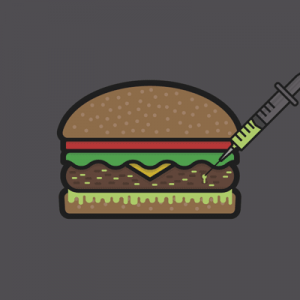Food Isn’t Food Anymore: The Frightening World of Fillers
The cost of food is lower than it ever has been before.
Food fillers are lowering the cost of meat — a cheeseburger now costs less than produce. But are these fillers helping us or hurting us?
What are food fillers?
- Additives: Fillers help bulk up the weight of food. This helps lower food prices.
- Fillers are mostly found in processed meats.
- Meat fillers can lower the cost of meats by 10-30%
- The average national cost for 1lb of 100% ground beef, which likely contains filler, is $3.808
- The cost of organic ground beef is approximately $4.25/lb
While lowering the cost of food sounds like a great idea, what we’re putting in the food may be costing us.
Cellulose
- Cellulose is a natural component found in corn and many plants used in the production of paper
- Much of the cellulose used in food is derived from wood pulp
Used in cereal, shredded cheese, salad dressing and ice cream - Humans can’t digest cellulose. Adding it to food makes for a no-calorie, nonfat filler
- Cellulose appears in many high-fiber snacks and eating organic won’t help you avoid it.
- Watch out for ingredients like microcrystalline cellulose (MCC), cellulose gel, cellulose gum or carboxymethyl cellulose
Soy
- Soy derivatives can be found filling a variety of foods, from frozen yogurt to ground beef
- “Vegetable proteins”
- Soy can be found in almost 60% of the food sold in supermarkets
- In ground meats, soy acts as a cheap filler, lowering both the price and quality of the meat
- Soy contains high levels of phytic acid, an anti-nutrient that steals and eliminates important vitamins and minerals from the body
Olestra
- Olestra is a fat substitute synthesized by Procter and Gamble
- The human body can’t digest the big molecules it is made of, so the fat substitute contributes 0 calories when consumed
- Introduced in the late 90’s by Frito-Lay and included in Fat Free Pringles
- Products containing Olestra were originally required to warn customers of the risk of “loose stools”
- Within 4 years of introduction, 15,000 people had called a hotline set up specifically to take adverse-reaction complaints
- In 2003, the FDA removed the warning label requirement
- Olestra appears to interfere with the body’s absorption of critical nutrients such as beta-carotene and lycopene
Carrageenan
- Carrageenan is a gel extracted from seaweed
- It’s used as a thickening agent and emulsifier
- You can find it in dairy many dairy products such as cottage cheese, ice cream and chocolate milk, where it is used to keep the component from separating
- It is also injected into raw chicken and other meat to make them retain water, making your meat appear bigger and better than it is
- Seaweed doesn’t generally have adverse health effects, but carrageenan is widely used in meats as a way to trick the consumer
Potassium Bromate
- Potassium bromate is a component that helps bread to rise quickly and puff up during baking
- Bread dough is bound together by gluten molecules
- In order for gluten to join to other gluten, it requires oxidation
- Potassium bromate speeds up the oxidation process considerably
- Bread made with potassium bromate ends up being fluffy, soft and unnaturally white
- In 1982, Japanese researchers published the first study linking potassium bromate to thyroid and kidney cancer in mice
- If bread is not baked long enough, or too much potassium bromate is added before baking, the amount in the end product can be much higher than recommended
- The likelihood of consuming potassium bromate is increased in fast food
- Potassium bromate is illegal in China, the European Union, Canada, Brazil and many other countries. It is legal in the U.S.
Even eating organic won’t eliminate these unwanted fillers from your diet.
Educate yourself on what you’re eating.
A good rule of thumb — the more ingredients are in a product, the less natural it is likely to be
Sources:
- http://recipes.howstuffworks.com/food-fillers-101.htm
- http://abcnews.go.com/Health/grossest-things-food/story?id=16824388
- http://eatthis.menshealth.com/slide/scary-ingredient-1-olestra?slideshow=186430#sharetagsfocus
- http://www.businessinsider.com/forget-food-price-inflation-its-actually-cheaper-than-it-has-ever-been-2010-10
- http://www.health.com/health/gallery/0,,20588763_17,00.html
- http://www.livescience.com/36206-truth-potassium-bromate-food-additive.html
- http://healthyeating.sfgate.com/soy-flour-hamburger-extender-11570.html
- http://www.examiner.com/article/soy-free-food-101-a-list-of-soy-derivatives
- http://nutrition-now.com/2012/05/the-dangers-of-soy-a-dark-side-to-a-popular-protien
- http://beefmagazine.com/blog/price-pound-drives-consumer-beef-sales

